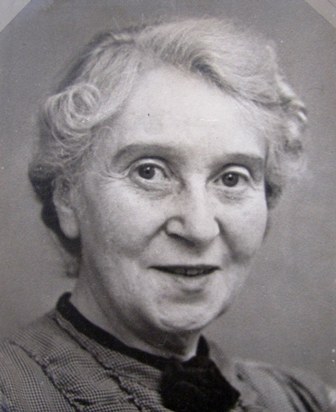Search for Names, Places and Biographies
Already layed Stumbling Stones
Suche
Aurelie Levison (née Roos) * 1879
Woldsenweg 9 (Hamburg-Nord, Eppendorf)
1941 Riga
ermordet
further stumbling stones in Woldsenweg 9:
Alice Feldmann, Paula Feldmann, Elisabeth Wulff
Aurelia Rahel Levison, née Roos, born 2/22/1879 in Ahlen, deported to Riga on 12/6/1941
Woldsenweg 9
"Ms. Levison was the mother of my daughter-in-law; I often visited her up to my emigration in January, 1941. …Ms. Levinson at the time was waiting for her visa, and as she counted on being able to leave Germany, she bought a lot of clothes and linen and also household goods. She often told me about her purchases, and we discussed what might be especially useful for her emigration, and then we went shopping together", Paula Rosenberg testified at the compensation hearing in 1954. Aurelia Levinson at the time was obviously still confident to succeed in leaving Germany. To this end, she completed several "questionnaires for shipping personal relocation goods” between January, 1940 and November, 1941 – the last one on November 4th, one month before her deportation to Riga on December 6th, 1941.
Aurelia was born as the daughter of Abraham and Henriette Roos, née Nihl, in Ahlen, Westphalia. The membership roster of the Ahlen Volunteer Fire Department gave Abraham’s profession as a "sheep trader". Aurelia’s husband Louis Levinson came from Bünde, a Westphalian town approx. 100 km away from Ahlen. We don’t know when the Levinsons came to Hamburg with their daughters Margarethe and Dorothea, born in Berlin in 1898 and 1892. Louis Levinson joined the Hamburg Jewish Community in May, 1917; he was a shareholder of the Hamburg–Altonaer Wach- und Schliessgesellschaft GmbH with headquarters at Bleichenbrücke 25/29, a security firm. The well-to-do Levinsons lived in stately apartments in Jungfrauenthal, Oberstrasse and Rothenbaumchaussee. After the death of her husband on December 18th, 1934, Aurelia Levinson moved to a three-room apartment in Woldsenweg. She didn’t have space for all her beautiful appointments, but the mahogany living-room furniture with its big bookcase, the paintings and Persian rugs suited her new home in Woldsenweg well.
Toni Sachs, a longtime lady friend of Aurelia’s, gave the following account: "During my frequent visits to her home, I always had the impression of solid prosperity and good taste.” When the Altonaer Wach- und Schliessgesellschaft was "aryanized” on September 9th, 1938, the customs investigation department started procedures on account of "suspected capital flight” against Aurelia Levinson, who, together with her daughters and her son-in-law Kurt Rosenberg, was the heir and owner of the company. As she was Jewish, all her assets were subject to a "security order”, which meant that she was only allowed to dispose of an arbitrarily fixed amount of money per month from her account. In this situation, she rented out a room of her apartment to Alice Feldman (q.v.) and applied for an entry visa for Bolivia. Almost 60 years old, she starting training as a physiotherapist and enrolled in language and housekeeping courses. Having been denied entry to Bolivia, she tried to get a visa and a permit to work as a housemaid in the Dominican Republic until shortly before her deportation, hoping to settle in a new Jewish community project that had been founded in Sosúa. But she was deported to Riga on December 6th, 1941 with 752 other people, of whom only 27 survived. Aurelia Levison was not among them.
Her daughters Margarethe and Dorothea eventually succeeded in reaching the USA.
Translated by Peter Hubschmid
Kindly supported by the Hermann Reemtsma Stiftung, Hamburg.
Stand: March 2017
© Maria Koser
Quellen:1; 2; 4; 6; 8; StaH 314-15 OFP, R 1938/3074; StaH 314-15 OFP, Fvg 8061; StaH 351-11 AfW 4414; Jahnke, Befreiung, in: Gummersbach, Der Weg, 1988, S. 68.
Zur Nummerierung häufig genutzter Quellen siehe Link "Recherche und Quellen".


